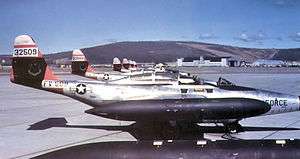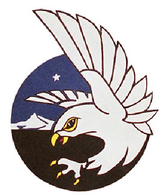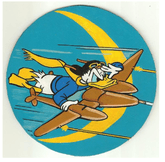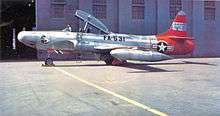449th Fighter-Interceptor Squadron
The 449th Fighter Interceptor Squadron is an inactive United States Air Force unit. Its last assignment was with 11th Air Division stationed at Ladd Air Force Base, Alaska, where it was inactivated on 25 August 1960.
| 449th Fighter Interceptor Squadron | |
|---|---|
 449th Fighter Interceptor Squadron Northrop F-89J Scorpions | |
| Active | 1943–1945; 1947–1960 |
| Country | |
| Branch | |
| Type | Fighter interceptor |
| Engagements | |
| Insignia | |
| 449th Fighter-Interceptor Squadron emblem (Approved 4 December 1951)[1] |  |
| 449th Fighter Squadron emblem (World War II) |  |
The squadron was first activated in 1943 as the 449th Fighter Squadron and engaged in combat in China during World War II. Following VJ Day, it returned to the United States and was inactivated. It was reactivated in Alaska in 1947.
History
World War II
The squadron was first organized in China as the 449th Fighter Squadron and equipped with Lockheed P-38 Lightnings. It fought in the China Burma India Theater from 1943 to 1945.[1] Former Heisman Trophy-winner Tom Harmon was a member of the unit during their stint in the CBI.
Alaskan air defense
The 449th was reactivated at Adak Army Air Field as part of Alaskan Air Command in September 1947 and equipped with Northrop P-61 Black Widow night fighters. Its aircraft and personnel were drawn from the 415th Night Fighter Squadron, which was simultaneously inactivated.[2] The Black Widows used as interceptors against Soviet aircraft intruding into North American airspace.

The squadron began to re-equipped with North American F-82 Twin Mustangs in 1948,[1] but only became a Twin Mustang unit upon moving to Ladd Air Force Base in 1949.[3] it received additional aircraft from Far East Air Forces after the model was withdrawn from the Korean War. These aircraft were modified to the F-82H model with the addition of cold weather equipment and additional de-icers. Many of these fighters operated with Strategic Air Command where they served as escorts for the massive Convair B-36 Peacemaker bomber during long flights over the Arctic. The 449th Fighter-Interceptor Squadron was the last USAF unit equipped with the F-82, retiring the model in 1953[4] when a lack of parts made it impossible to keep the aging airframes flying. The retirement of the F-82 marked the end of front-line use of USAF propeller driven fighter aircraft. Many were ultimately scrapped in Alaska.

The squadron replaced their Twin Mustangs with jet Lockheed F-94 Starfires armed with 20mm cannon in 1952. The Starfire was not suited to service in the Arctic. When equipped with cold weather gear, the radar operator in the rear seat was cramped and found it difficult to operate. Moreover, the aircraft proved difficult to maintain and had a high accident rate. By mid 1954, the squadron had converted to the Northrop F-89 Scorpion. It initially flew a mix of F-89Cs, armed with cannon and F-89Ds, armed with Mighty Mouse rockets in wing pods.[4] In 1957, the squadron converted to the F-89J, which was armed with the nuclear MB-1 Genie air to air missile. After August 1958, the squadron maintained air defense of northern Alaska under the command of North American Air Defense Command.[6] It inactivated in 1960[1] along with turnover of Ladd to the United States Army as part of Fort Wainwright.
Lineage
- Constituted as the 449th Fighter Squadron, Two Engine on 2 August 1943
- Activated on 26 August 1943
- Inactivated on 25 December 1945
- Activated on 1 September 1947
- Redesignated: 449th Fighter Squadron, All Weather on 20 July 1948
- Redesignated: 449th Fighter-All Weather Squadron on 20 January 1950
- Redesignated: 449th Fighter-Interceptor Squadron on 1 June 1951
- Discontinued and inactivated on 25 August 1960[1]
Assignments
- 51st Fighter Group, 26 August 1943 – 13 December 1945 (attached to 23d Fighter Group until October 1943)
- Alaskan Air Command, 1 September 1947 (attached to 5001st Composite Group after 1 May 1949)
- 5001st Composite Wing, 1 July 1949
- 11th Air Division, 8 April 1953
- 5001st Air Defense Group, 20 September 1954
- 11th Air Division, 1 October 1955 – 25 August 1960[1]
Stations
|
|
Aircraft
|
|
See also
References
Notes
- Maurer, pp. 555–556
- Maurer, pp. 508–509
- Dalby, p. 12
- Dalby, p. 16
- Aircraft is Lockheed F-94A-5-LO Starfighter serial 49-2531
- Dalby, p. 17
Bibliography
![]()
- Dalby, Ron, ed. (2001). Top Cover and Global Engagement: A History of the Eleventh Air Force (PDF) (reprint ed.). Anchorage, AK: Alaska Quality Publishing.
- Davis, Larry (1996). F-82 Twin Mustang (Squadron/Signal Mini in Action Series Number 8). Carrollton, Texas: Squadron/Signal Publications inc. ISBN 0-89747-367-1
- Pape, Garry R.; Campbell, John M.; Campbell, Donna (1991). Northrop P-61 Black Widow: The Complete History and Combat Record. Minneapolis, MN: Motorbooks International. ISBN 978-0-879385-09-5.
- Maurer, Maurer, ed. (1982) [1969]. Combat Squadrons of the Air Force, World War II (PDF) (reprint ed.). Washington, DC: Office of Air Force History. ISBN 0-405-12194-6. LCCN 70605402. OCLC 72556.
Further reading
- Jackson, Daniel (2010). The Forgotten Squadron: The 449th Fighter Squadron in World War II - Flying P-38s with the Flying Tigers, 14th Air Force. Atglen, PA: Schiffer Publishing, Ltd. ISBN 978-0764335372.
External links
| Wikimedia Commons has media related to 449th Fighter-Interceptor Squadron. |
- Jackson, Dan (31 October 2011). "449th Fighter Squadron, 14th Air Force footage of Japanese Surrender". YouTube. Retrieved 2 May 2016.
- Stubblebine, David (3 May 2010). "P-38 Lightning aircraft of USAAF 449th Fighter Squadron, China, 1945". WW2DB. Retrieved 2 May 2016. (photograph of Squadron P-38)
- Rickard, J. (30 May 2007). "Lockheed P-38 Lightning in China, Burma and India (CBI)". WW2DB. Retrieved 2 May 2016.
- "Lt. Richard Harding & Lt. Col. Ward Kemp CO of 449th FIS, Ladd AFB, Nov 1952". Jet Pilot Overseas. 24 August 2012. Retrieved 2 May 2016.
.jpg)